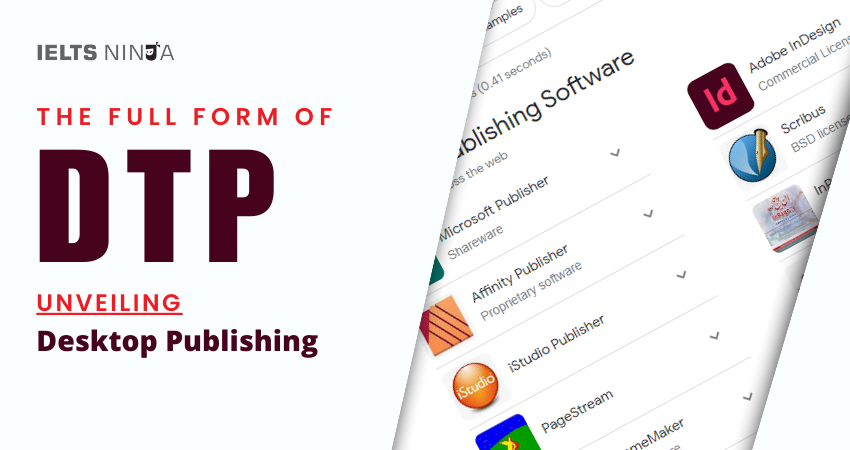The full form of DTP stands for “Desktop Publishing”, and it refers to the process of creating documents and publications using computer software and hardware, typically on a personal computer or desktop workstation. DTP involves the design, layout, and formatting of various printed or digital materials, such as brochures, magazines, newsletters, flyers, books, and other visual content. In this guide, we will explore the details of DTP, its history, and its significance in publishing and design.
Key Details of Desktop Publishing (DTP):
History of DTP:
- DTP emerged in the late 20th century as personal computers and specialized software became widely accessible.
- Before DTP, publishing and typesetting were labor-intensive processes that involved manual typesetting and layout using metal type or photographic methods.
Components of DTP:
- Software: DTP software, such as Adobe InDesign, QuarkXPress, Microsoft Publisher, and Adobe PageMaker, provides tools for layout, typography, image placement, and more.
- Hardware: A personal computer or workstation with sufficient processing power, memory, and storage is essential for DTP work. High-resolution monitors and color printers are also common hardware components.
- Graphics: DTP often involves the use of graphics, images, and illustrations. Image editing software like Adobe Photoshop is used to prepare and manipulate visual elements.
- Typography: DTP software includes extensive font libraries and tools for text formatting, ensuring precise control over typography.
- Page Layout: DTP software allows designers to arrange text, images, and other elements on pages or screens, specifying page sizes, margins, and columns.
- Templates: Pre-designed templates can expedite the creation of various types of publications, from business cards to magazines.
Functions and Significance of DTP:
- Design and Layout: DTP enables designers to create visually appealing and organized layouts for printed and digital materials.
- Typography Control: Precise control over fonts, spacing, and text alignment results in professional-looking documents.
- Image Integration: DTP software allows for the integration of high-quality images and graphics into publications.
- Flexibility: Designers can make real-time changes to layouts and content, facilitating quick revisions and updates.
- Cost-Efficiency: DTP significantly reduces the cost and time associated with traditional typesetting and layout methods.
- Consistency: Templates and style guides ensure consistent design elements throughout a publication or brand materials.
- Digital Publishing: DTP is essential for creating digital publications, eBooks, eMagazines, and interactive multimedia content.
- Accessibility: DTP tools help create materials that are accessible to individuals with disabilities through proper formatting and tagging.
Also Read: Best online IELTS coaching & training academy
Industries Using DTP:
- Publishing: DTP is widely used in book and magazine publishing, allowing for the efficient production of printed and digital publications.
- Marketing and Advertising: DTP is crucial for designing marketing collateral such as brochures, posters, banners, and advertisements.
- Corporate Communication: Businesses use DTP for creating newsletters, reports, presentations, and corporate branding materials.
- Education: Educational institutions use DTP for creating textbooks, educational materials, and multimedia content.
- Media and Entertainment: DTP is involved in designing movie posters, CD/DVD covers, and promotional materials for the entertainment industry.
- Government: Government agencies use DTP for designing official documents, reports, and public awareness campaigns.
DTP and Digital Age:
- With the advent of the internet and digital media, DTP has evolved to include web design, multimedia presentations, and e-publishing.
- DTP professionals often work on web design, creating responsive websites and digital marketing materials.
- The integration of DTP with digital media has expanded the role of desktop publishers in the modern communication landscape.
Conclusion:
Desktop Publishing (DTP) is a vital tool for creating visually engaging and organized printed and digital materials. It has revolutionized the publishing and design industries, making it more accessible and cost-effective to produce high-quality publications. DTP continues to evolve in the digital age, encompassing web design, multimedia presentations, and electronic publishing, ensuring its continued relevance in various fields.








